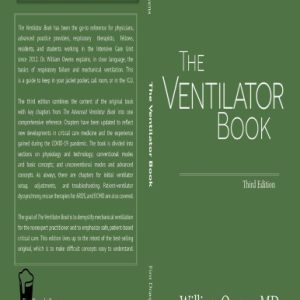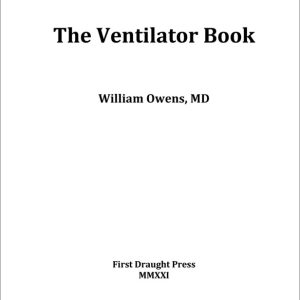The Ventilator Book
$9.99 Original price was: $9.99.$2.99Current price is: $2.99.
- Title: The Ventilator Book
- Author(s): William Owens
- Publisher: First Draught Press
- Year: 2021
- Edition: 3rd Edition
- Language: English
- Pages: 280
- Ebook: PDF
- File size: 8 MB
- ISBN Number: 0985296569, 9780985296568
- CBID: CBM441
Description:
The third edition of The Ventilator Book combines the content of the original book with key chapters from The Advanced Ventilator Book into one comprehensive reference. The Ventilator Book has been the go-to reference for physicians, advanced practice providers, respiratory therapists, fellows, residents, and students working in the Intensive Care Unit since 2012. It has been published in four languages, with over 50,000 copies in print. Dr. William Owens explains, in clear language, the basics of respiratory failure and mechanical ventilation. This is a guide to keep in your jacket pocket, call room, or in the ICU. Chapters have been updated to reflect new developments in critical care medicine and the experience gained during the COVID-19 pandemic. The book is divided into sections on physiology and technology; conventional modes and basic concepts; and unconventional modes and advanced concepts. As always, there are chapters for initial ventilator setup, adjustments, and troubleshooting. Patient-ventilator dyssynchrony, rescue therapies for ARDS, and ECMO are also covered.The goal of The Ventilator Book is to demystify mechanical ventilation for the nonexpert practitioner and to emphasize safe, patient-based critical care. This edition lives up to the intent of the best-selling original, which is to make difficult concepts easy to understand.
Introduction
So, here you are in the Intensive Care Unit at 3:30 in the morning. The Emergency Department has just admitted a patient to your service—a young man with a rather sudden onset of fever, rigors, and respiratory distress. He had to be intubated in the ED and the ventilator seems to be alarming with a nerve-racking frequency. His chest X-ray looks horrible, with diffuse infiltrates and consolidations. The ICU respiratory therapist looks at you and asks the question you have been dreading since the patient arrived— “Doctor, what vent settings do you want?”
This is a familiar story for those of us who spend a lot of time in the ICU, and since the advent of the COVID-19 pandemic, it’s an experience that just about every student and resident has at least once during his or her training. Mechanical ventilation can be intimidating—it has its own terminology, not all of which makes sense; it’s a life-sustaining technology, and misapplication can have serious consequences; and practitioners of mechanical ventilation tend to talk in esoteric ways about what the ventilator is doing. This can confuse even the smartest practitioner.
To make things worse, there aren’t a lot of practical resources for busy clinicians who just need some quick guidance on how to adjust the ventilator. Don’t get me wrong—there are plenty of great textbooks on mechanical ventilation. And, if you have the time, they are well worth reading. The operative word, however, is “time.” Reading a hundred pages on the pros and cons of pressure-controlled ventilation may be a good use of an afternoon in the library but it’s wholly impractical while taking care of patients in a busy ICU. What’s necessary is a how-to guide, and that’s why I first wrote this book in 2012. It may seem basic to experienced ICU clinicians, but then again, it’s written for the nonexperts in the room. I would also venture to say that most success in critical care medicine comes from doing the basic stuff right on a consistent basis.
This is now the third edition of The Ventilator Book, which I have enjoyed putting together. I have combined some new material with updated chapters from the second edition of The Advanced Ventilator Book to create a
more comprehensive single resource. I would like to thank many of my readers for their feedback on previous editions, and I hope you’ll find that it had an impact on this one.
Since there’s only one author, this book will be biased. Not too much, I hope, but I’m not delusional enough to think that my approach is completely objective. Like everyone else in medicine, personal anecdote and experience has shaped my practice.
This book is intended to teach you about the practical aspects of mechanical ventilation. The chapters are short, and each can be read easily within 15-20 minutes. Here, you’ll learn to speak the language and understand the rationale for why things work and why intensivists do what they do. I also believe that understanding the “whys” of what we do is important, and I’ve included some chapters on respiratory physiology and technology.
At this point, it’s necessary for me to point out that while this book is chock-full of great advice, none of it is specific to the care of any individual patient. Have any of your faculty ever told you that the patients don’t read the textbook? They’re right. Every patient needs an individualized approach. Believe it or not, my lawyer didn’t make me write this. It’s just common sense.
























Reviews
There are no reviews yet.